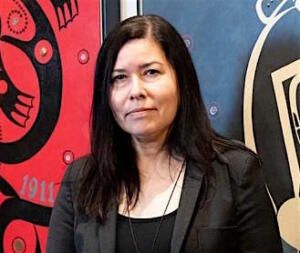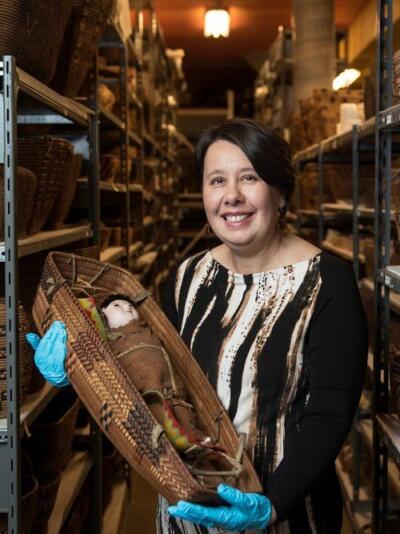1742 Knowing the Northwest Coast
Knowledge Within: Treasures of the Northwest Coast
by Pam Brown, Jisgang Nika Collison, Anthony Alan Shelton, and Jodi Simkin (curators). Edited by Caitlin Gordon-Walker
Vancouver: Figure 1 Publishing, 2022, in collaboration with the UBC Museum of Anthropology
$60.00 / 9781773270999
Reviewed by Liz Hammond-Kaarremaa
*
 A good book should leave something behind in your mind, little nuggets of treasure — a thought to ponder, a quote to repeat, an ending that will not end, a scene you see again and again, a relationship that deepens, a new insight to see with, an image that says so much. Knowledge Within: Treasures of the Northwest Coast leaves you with a selection of these gems.
A good book should leave something behind in your mind, little nuggets of treasure — a thought to ponder, a quote to repeat, an ending that will not end, a scene you see again and again, a relationship that deepens, a new insight to see with, an image that says so much. Knowledge Within: Treasures of the Northwest Coast leaves you with a selection of these gems.
It is an unusual book. The overarching concept is a book whose chapters each represent a museum or art gallery whose holdings include Indigenous “works of art.” Each chapter is written by someone very familiar with the organization — a current or past staff member. While the concept of Northwest Coast First Nations material ties each chapter together, each chapter is unique and presents different offerings: a history of an institution, collection or of a people; the philosophical basis the organization is built on; an overview of important holdings or exhibits; or, an intention — to make things right.

An image that brilliantly reflects a central motif of the book, and an image I keep seeing in my mind, is Marianne Nicolson’s exhibit Wanx’id: “to hide, to be hidden,” a series of eight dark glass boxes that resemble bentwood boxes, an installation discussed in the chapter on the Museum of Anthropology (MOA) at UBC. The outsides of the boxes are smooth plain black glass with the inside walls etched with designs typically seen carved on the outside of wooden boxes. The floor of the boxes contains a ghostly image transparency that requires a light beneath to illuminate the photo. It is not until the viewer makes an effort to peer over the edge and down into the box that the image is revealed, and then the viewer must spend a lot more effort to think about what these boxes are trying to tell us.


Anthony Alan Shelton, former Director of MOA and one of the curators of this book, when discussing Nicolson’s boxes, wrote “Each of these works helps us rethink the museum; they challenge us to amplify the sensual codes required to understand the original meanings of the things it holds…. and they entreat us to acknowledge the parameters, rights, and limitations to expressing different types of knowledge.”
Bentwood boxes were used on the coast to store food, clothing, and utensils. Intricately carved boxes of treasures were for potlatch valuables — masks and regalia, only brought out to be used in dances. Drawing on the box of treasures metaphor, Franz Boas, “The Father of American Anthropology,” imagined his 1896 book (heavily contributed to by George Hunt), The Social Organization and the Secret Societies of the Kwakiutl Indians, as a storage box for “laws and stories.” Similarly, the late Ira Jacknis in The Storage Box of Tradition: Kwakiutl Art, likened museums to storage boxes of tradition. Nicolson’s bent glass boxes Wanx’id impels us to rethink museums, what they store, how objects are cared for and who is presenting them. Each chapter in Knowledge Within: Treasures of the Northwest Coast explores how particular museums do that.

I mention Boas, as he is also the father of one of the earliest museum displays of Northwest Coast objects. The Smithsonian’s American Museum of Natural History’s Hall of Northwest Coast Indians opened in 1899 and never changed for over 120 years. That is, until recently, when ten co-curators from ten Northwest Coast First Nations came together and redesigned it. One of those curators, Haa’yuup Ron Hamilton, wrote the foreword to Knowledge Within, which opens readers’ minds to the realities we need to acknowledge and address. He speaks of our “uncomfortable history of racism,” of an era when museum were repositories of colonial treasure displaying only the superficial object and not the deeper cultural knowledge and beliefs that created it.
Haa’yuup’s experience with many museums and the examples in this book show the possibilities of how these treasures can be respectfully cared for and shared.


Sharon Fortney, in her chapter on the Museum of Vancouver, takes us on a fascinating journey in search of baskets made by her grandmother. One learns how objects reflect their maker through choices made in the process of creating — the type of root used, how the root is split, motifs used, style, and many other personal choices. Careful looking at an object like a basket allows the ancestor to speak, and Fortney observes that “we see the genealogies of unknown basket makers written in the commonalities of their handiwork and that of their descendants.”
Traditional museum classifications can obscure information relating to memories, meanings, and communities. Fortney explains that museums can be a two-sided coin: how we see ourselves vs how others perceive us: “Until recently, museums were skewed towards the outside gaze… We have moved away from ‘experts’ telling stories about others, to people telling stories about themselves, enabling re-connections with traditional knowledge.”
Some of the institutions that stood out for me were those that had philosophical underpinnings, like the Sea Alaska Heritage Institute whose core value is Haa shuká: honouring ancestors and future generations. The Haida Gwaii Museum was created with the intention of making things right, and the Stó:lō Resource Centre built a “house of respect” containing experiences, ancestors, languages, and more.

These cultural foundations were guided by communities and elders who oversaw the types of space created, for example traditional clan houses containing exhibits, and who decided on the functions held within — not just exhibition space, but space for ceremonies with fire pits, archives, and learning rooms, respectful places to house ancestral languages.
Some of what we so readily call “museums” go even further and place great importance on future generations, like the Squamish Lil’wat Cultural Centre, where cultural ambassadors are trained to show visitors around and where elders are paired with youth to transfer knowledge such as collecting, preparing, spinning fibres and weaving blankets, and where a business program is taught through the lens of a museum.


Running throughout are stories are landmark themes and events: the story of the banned Potlatch (U’mista U’mista Cultural Centre at Alert Bay); Billy Assu’s house posts (Nuyumbalees Cultural Centre at Quathiaski Cove); the stories, territories, families totem poles represent; origin stories; how Vancouver International Airport (YVR) became the largest collection of Northwest Coast art; and the story of Bill Reid (Bill Reid Gallery in Vancouver).
Underlying much of the book are discussions of respect, cultural context, the importance of relationships between cultures, and our relationship with nature, which can be evidenced in cultures as well as institutions.
An insight I am left with after reading this so aptly named book, Knowledge Within: Treasures of the Northwest Coast, is that the words “museum” or “art gallery” — when conceived, built, governed and operated by First Nations — no longer convey what those institutions do. They are more like boxes of treasures or houses of knowledge.


Together, the book’s chapters offer new perspectives and reflect a complexity that requires the reader to think deeply about the issues we face on our journeys of understanding and reconciliation. Indigenous cultures cannot simply be translated or adjusted to western cultures by employing colonial intellectual ideas or frameworks. Cultures are made up of layer upon layer of tradition and precedent, and we can only open our minds to learn them. Finding that knowledge within is not simple, especially in BC where there is not one Indigenous nation. There are many nations, many territories, many cultures. The museums in this book reflect those territories, people, and stories, and each chapter opens a door to them.
As Haa’yuups foretells, there is much of value to discover within this book of treasures.
*

Retired from Vancouver Island University where she held the position of Director of Research Services, Liz Hammond-Kaarremaa now spends much of her time studying Coast Salish textiles. Along with a MA in Educational Technology, she holds a Master Spinners Certificate. She is a Research Associate with the Smithsonian and with VIU. She has worked with various museums including: the British Museum, Pitt Rivers Museum in Oxford, the RBCM, MoA and the Burke Museum in Seattle in helping to identify yarns, fibres, tools and techniques used to create the yarns. She was instrumental in identifying a rare blanket in the Burke Museum confirmed to be made of woolly dog hair. She has given many presentations and workshops on the subject of Coast Salish spinning and textiles to Coast Salish spinners and weavers and has written articles on the subject for magazines such as Selvedge, Spin-Off, and Ply — and for BC Studies about the use of diatomaceous earth in Coast Salish blankets. She lives on Protection Island, BC, in Snuneymuxw territory. Editor’s note: Liz Hammond-Kaarremaa has also reviewed books by Robert Kardosh, Robin Laurence, & Kūn Jaad Dana Simeon, Aldona Jonaitis, Dempsey Bob, Kathryn Bunn-Marcuse & Aldona Jonaitis, and Leslie H. Tepper, Janice George, & Willard Joseph for The British Columbia Review, and she has has contributed a Tribute to Bill Holm.
*
The British Columbia Review
Editor and Publisher: Richard Mackie
Formerly The Ormsby Review, The British Columbia Review is an on-line book review and journal service for BC writers and readers. The Advisory Board consists of Jean Barman, Wade Davis, Robin Fisher, Barry Gough, Hugh Johnston, Kathy Mezei, Patricia Roy, Maria Tippett, and Graeme Wynn. Provincial Government Patron (since September 2018): Creative BC. Honorary Patron: Yosef Wosk. Scholarly Patron: SFU Graduate Liberal Studies.
“Only connect.” – E.M. Forster

One comment on “1742 Knowing the Northwest Coast”
Lovely inticong article, beautifully written Liz HK.